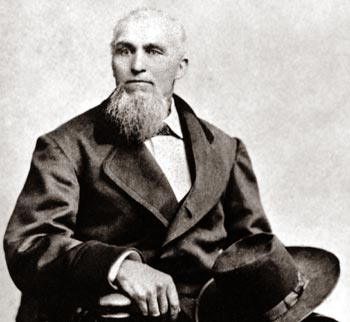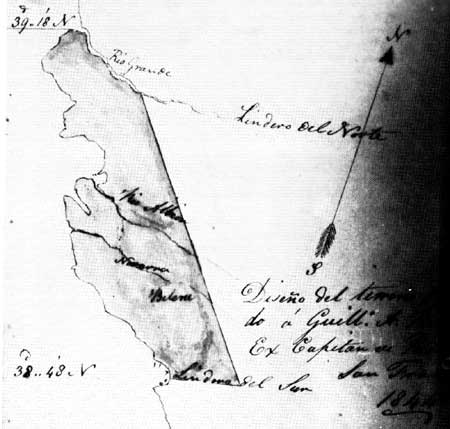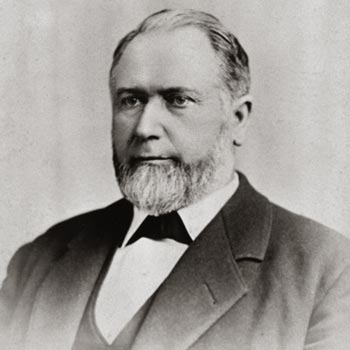

|
|
Capt. Charles Fletcher,Seaman, Ships Carpenter and First Settler of Navarro, Mendocino County, California ca. 1851© by Hillary de Mandeville Adams, Ph.D. 2003 Who was Capt. Charles Fletcher?Charles Fletcher gave his birthplace as: “the China Sea, on Board the Schooner 'Wild Cat'.” The information appears in a special census taken on November 14, 1850 for Rancho Sausalito, Marin County.1 He gave his age that year as 21, which would indicate a birth year of 1829. The voter registration records of 1894, Mendocino County, describe Fletcher as 6' 5 1/2" tall, with a light complexion and gray eyes. He gave his age at that time as 65, said that he was “born at sea” and was “Scotch” in background. Apparently his father was a Scottish sea captain in the China trade, but the name of the ship, “Wild Cat,” suggests an American connection. 
Charles Fletcher, age about 60. Robert J. Lee Collection (Nichols) L-07948-AUntil he arrived at San Francisco in 1849, Charles Fletcher seems to have spent his entire life as a sailor and ship's carpenter. His granddaughter, Elsie Schaeffer Nystrom (later Farnsworth) stated in a taped interview conducted in Potter Valley in 1975 (Mendocino County Museum, Willits), that her grandfather came around the Horn in 1849 during the Gold Rush. She says “he sailed into the [San Francisco] Bay when there were just a few houses along the shore... mined for a while, and he didn't like that... so he came on, sailing up the coast, looking for a place to make his home... he came to the Navarro River and that's what he liked.2 The family stories do not record the brief time that Fletcher spent in Marin County or how he made his living there. The census shows that, late in 1850, Fletcher was living at Rancho Sausalito where he gave his occupation as “farmer”. He was apparently working for Capt. William Richardson, the owner of Rancho Sausalito. Fletcher's boarding house was only a few doors away from Richardson's hacienda. Rancho AlbionRichardson, an Englishman, arrived at the Presidio of San Francisco in 1822 as mate of an English whaling ship, the Orion. He was rebaptized “Guillermo Antonio Richardson” at the mission in San Francisco at age 27. Both of his Mexican land grants are in that name. Richardson became a Mexican citizen in 1830, married a Mexican wife, and became the first settler of Yerba Buena Pueblo (present city of San Francisco) in 1835. By 1836, he had obtained a land grant for Rancho Saucelito (as it was then spelled) moving there from Yerba Buena in 1841. On September 24, 1844, Richardson petitioned Governor Micheltorena for recompense, in the form of a second land grant, for his many unpaid years as captain of the Port of San Francisco. In response, he was issued a “passport”, a right to search for and occupy land “two leagues by ten” on the “unoccupied” north coast. Richardson called the area he eventually chose “Rancho Albion” after his homeland. The grant probably stretched from Mal Paso (near present Irish Beach) to the south bank of the Rio Grande (Big River), and about six miles inland (near the old location of Hop Flat on the Navarro River ). Richardson believed the grant contained 50,000 acres. He submitted a description and diseno (rough map) in March, 1846, only a few months before the outbreak of the Bear Flag Rebellion. 
Richardson's land grant for Rancho AlbionThe Americans, led by Charles Fremont, captured California in June of 1846. On September 9, 1850, California became a state, with the first capital at Monterey. Land laws changed drastically. The California Land Act, passed in 1851, was created to investigate the validity of all Mexican Land Grants, including Richardson's Rancho Sausalito and Rancho Albion3 Supply ships anchored off the Albion River, where Richardson had a simple, house, and ran stock on the land. Richardson supplied both food and fresh water from his ranchos to the gold fields. When Fletcher arrived on the north coast, ca. 1851, Richardson's grants, like all other Mexican land grants in the new state of California were being contested in the courts. Many men like Fletcher, who had originally come to California looking for gold, soon left the gold fields and spread out over the state seeking land upon which to settle. Under American law, unclaimed land could be settled by simple occupation (“squatting”) and the recording of a claim. By the terms of the far more complicated Mexican grants, Richardson needed to prove that he had built a house, was either running cattle and/or had cultivated the land, and had followed the many steps required by Mexican law. According to Robert Ryal Miller, who has written the definitive book on Richardson, few people completed all of the steps required, thus opening their claims to doubt. Between 1853 and 1856, both Richardson and Garcia, who owned the next rancho to the south, were selling portions of their land to help pay the costs of their court battles. Richardson died on April 20, 1856. The court battles were continued by his son, Estaban (Stephen). Charles Fletcher was the only one of those who arrived ca. 1851 to settle on Richardson's Rancho Albion. Fletcher was the first person to settle near the mouth of the Navarro River. Although no deed of record from Richardson to Fletcher has been located, it seems likely that Richardson knew of Fletcher's arrival and settlement there. The coastal trail ran directly past Fletcher's rough, redwood cabin. By 1852, American and European settlers were beginning to move up and down the coast. They had to ford the Navarro River, which at that time ran deep and swift even in the summer. Not all of the steps in the complicated Mexican granting process had been completed for Rancho Albion. Although Richardson could argue that the process was interrupted due to the war of 1847, he needed to make his best possible case. In presenting evidence for Rancho Albion before the District Court of Appeals on October 19, 1953, his son, Estaban, included Fletcher's settlement at the mouth of the Navarro as part of the “improvements” on Rancho Albion. Martha Sullenberger (Dogholes and Donkey Engines, Sacramento :1980) discusses Rancho Albion as described by Richardson's son, Estaban (Stephan) in the court records. She concludes that, “There were apparently two areas of settlement, one on the Navarro River, which had one house and 150 cultivated acres.”4 The amount of cultivated land is clearly exaggerated, but certainly a “house” existed there by June of 1852. Ford's 1852 Diary
Jerome B. Ford at age 55 (taken 1876 ) Robert J. Lee Collection (Wilder) L-08033In that year, Jerome Bursley Ford and Mr. Warner drove five yoke of oxen up the coastal trail from Smith's mill at Bodega to the northern bank of the Rio Grande (Big River). The oxen would pull logs to supply a lumber mill which Ford and his partners planned to build on the headlands. The mill was a venture of the California Lumber Manufacturing Company, officially formed on June 20, 1852. On Tuesday, June 15, 1852 Ford recorded the following in his diary: ... “Stayed at The 'Navata [Navarro]House.' Could not Ford the River - 'No Supper'— very foggy all day and evening.” And for Wednesday, June 16, 1852: “Took an Early Start and crossed the 'Navata' [Navarro] tide low' arrived at 'Portagees' Rancho at 6:00 a.m. had a good 'meal'—which I enjoyed much after being without 24 hours...” The Navarro River itself was so fast and deep in June of 1852 that Ford and Warner could not cross it at high tide. Ford's description of traditional summer flows of the Navarro River has been confirmed by interviews with descendants of early settler families.5 The “Navata” house mentioned by Ford was undoubtedly the rough, redwood cabin built by Charles Fletcher as described by his granddaughter, Elsie: “So the first little place he built there was made of redwood timber split by hand, and the shingles were made by hand. And that was his first home.” The cabin was probably situated near the then year-round stream by the present Inn. Charles Fletcher was probably not at home that night, since the men were hungry and had no meal. Fletcher was not only a generous man, but a good “shot” and an experienced fisherman. His granddaughter, Elsie, in her taped interview says: “he was a grand old man, my grandfather... easy going... very kind hearted.” No traveler would have left his home hungry. Nor could Fletcher have had his dug-out canoe in that year since the men could not get across the river at high tide. Fletcher's granddaughter, Elsie, tells us that Fletcher ferried people across the Navarro. Their horses and stock swam. “He made a boat out of a dug-out log, a redwood log. . . He ferried them back and forth across the Navarro River in this dug-out boat. There were no bridges, no roads or anything.” 6 If Fletcher had been at home, Ford would probably have given his name. The house, however, was surely there. The year of the arrival of Charles Fletcher at Navarro is probably the spring or summer of 1851 (see Next) Footnotes: “Who Was Charles Fletcher”(1) For more on the 1850 Marin Census and the Sausalito connection see Hillary Adams, “Charles Fletcher and the Sausalito Connection”, Kelley House Calendar, The Mendocino Beacon March 16 and 23, 2000. Copyrighted and footnoted versions of all Adams' articles about Charles Fletcher are available in local museums : Kelley House, Mendocino; Held-Poage House, Ukiah; Mendocino County Museum, Willits, California. The present website article brings the research up to date. (2) Tape No. 80-5-64X. Partially published by Bruce Levine et.al., Mendocino County Remembered, Vol. 1, pp. 137-141 (Elsie Farnsworth). Mendocino Historical Society. Ukiah, California: 1976. (3) See Robert Ryal Miller Captain Richardson, Mariner, Ranchero, and Founder of San Francisco. La Loma Press, Berkeley, California 1995 (Lib. of Congress No: 95-94673), Rancho Albion, pp. 114-115; Bear Flag Revolt p. 119. The patent for Rancho Sausalito was finally issued on August 7, 1879, by which time Richardson had died and the family had lost most of the land to debt and knavery (pp. 163 and 171-175: Throckmorton). Rancho Albion was held up in the courts for 20 years and was finally lost (p. 164). (4) Martha Sullenberger. Dogholes and Donkey Engines. A Historical Resources Study of Six State Park System Units on the Mendocino Coast, pp. 9-10. California Department of Parks and Recreation. Sacramento, California: 1980. For more on the Navarro House and Jerome Ford's trip, see Hillary Adams, “Jerome Ford” (In Search of the 'Portagee' Rancho-1), and: “In Search of the Portagee Rancho -2”, Kelley House Calendar, The Mendocino Beacon, July 15 and 22, 1999. NEXT > > |
|
Home PageAbout UsHow to HelpNSCR BoardCCC Grant and Bid DocumentsCCHE Planning & Construction
| ||
|
|